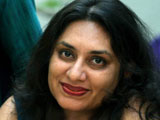Pakistan’s Fearless Women Journalists
by Bina Shah / January 8, 2013 / No comments
“The most dangerous place for women journalists seems to be their own places of employment.”

Journalists like Nighat Hunzai, above, face discrimination and violence for their gender in Pakistan. Photo: Internews Network. Creative Commons.
I recently attended a panel discussion in Karachi on the topic of media advocacy for women that was hosted by the Women’s Media Center, Pakistan (WMC). Funded by the US-based National Endowment for Democracy, and partnered with UNESCO and the German-based Friedrich Naumann Stiftung organization, the WMC is an independent organization that has been working to empower Pakistani women in the media since 2005.

- Pakistan is a country of contradictions – full of promise for growth, modernity and progress, yet shrouded by political, social and cultural issues that undermine its quest for identity and integrity. My bi-monthly column “Pakistan Unveiled” presents stories that showcase the Pakistani struggle for freedom of expression, an end to censorship, and a more open and balanced society.

- Bina Shah is a Karachi-based journalist and fiction writer and has taught writing at the university level. She is the author of four novels and two collections of short stories. She is a columnist for two major English-language newspapers in Pakistan, The Dawn and The Express Tribune, and she has contributed to international newspapers including The Independent, The Guardian, and The International Herald Tribune. She is an alumnus of the International Writers Workshop (IWP 2011).
Headed by veteran journalist Fauzia Shaheen, the WMC has trained 2,500 women journalists in workshops, conferences, seminars, and short courses. In the seven years that they’ve been active the WMC has taught women how to operate cameras—they learn how to shoot, edit, write scripts, and report from the field—and provided training in making documentaries, news packages, and news bulletins. Today, more and more female journalists and journalism students are demanding this kind of training all across the country. Being “competent and effective media professionals” will help them achieve their rightful place alongside male journalists in newsrooms, where they face huge amounts of discrimination.
Tellingly, only three percent of Pakistan’s journalists are women. Furthermore, those female journalists are discouraged from becoming crime or investigative reporters; instead they’re steered towards “women’s pages” and “women’s interests,” such as fashion, culture and the arts, child-rearing, and homemaking.
At the seminar, I listened to testimony from women journalists about how their stories were dropped in favor of stories written by male counterparts, how they face professional and personal pressure to not write about controversial stories concerning rape or sexual harassment, and how they themselves face sexual harassment on the job and online. In a country where journalism is the most dangerous profession, the most dangerous place for women journalists seems to be their own places of employment.
The participants at the seminar I attended also discussed a second role that women journalists have: They are able to create pressure groups that force the government to look at issues of gender discrimination and enact laws against them. Famous journalists in Pakistan who have done this successfully in the past include Beena Sarwar, Sherry Rehman (who now serves as Pakistan’s Ambassador to the United States), and Zubeida Mustafa, a pioneer in women’s journalism who was the first female editor of The Dawn’s op-ed pages, and who recently won the prestigious Lifetime Achievement Award for courage in journalism from the International Women’s Media Foundation.
But what the audience found most moving was the testimony of a young Sindhi journalist who goes by the name Veengas. Veengas spoke so emotionally about her fight to be heard as a woman journalist that her voice trembled and cracked several times during her presentation. She had been told over and over again that she couldn’t be taken seriously as a journalist because “she is a girl.” Yet she dared report on one of the most horrific stories of the year: The rape, kidnapping and forced conversion of a Hindu woman, Rinkle Kumari, by a group of influential men with political connections in the remote Sindhi town of Mirpur Methelo. The case went all the way to the Supreme Court, but was dismissed because of political pressure. Rinkle was eventually sent to live with her “husband,” but it is now thought that she is being kept as a sex slave by the men who continue to hold her in captivity.
The WMC writes in its vision statement that if women understand their rights, this will “ensure their significant participation in politics, [and] social [and] civil judicial forums.” To this end they’ve introduced the idea of gender equality to the Pakistani media, through an approach of civic activism, education, and participation in all aspects of the media, from reporting to production to editing, in print, radio, and television. Cell phones and digital media are also being recognized as important new platforms for information exchange, and as a way to circumvent the discrimination women journalists face in traditional media spaces. Because for Pakistani women, journalism isn’t just about gaining the opportunity to report the news, it’s about making their voices loud enough to be heard at all.




